NCERT TEXTBOOK QUESTIONS SOLVED
1. What have been the methods used to study the ruins of Hampi over the last two centuries? In what way do you think they would have complemented the information provided by the priests of the Virupaksha temple?
Ans: The engineer and antiquarian Colonel Colin Mackenzie brought the ruins of Hampi to light in 1800. He worked for many years in East India Company and prepared the first Survey maps of this site. His earlier information were based on the memories of priest of the Virupaksha temple and shrine of Pampadevi. From 1856 onwards, photographers started to record the pictures of monuments. The picture of the sites helped the scholars to study them. Dozens of inscription were collected from Virupaksha temples and other temples situated around temples.
Historians collected information from these sources other sources such as accounts of foreign travellers and literature composed in Kannada, Telugu, Tamil and Sanskrit languages used by the historians so that the History of the city could be reconstructed. These functions complemented the information given priests of Virupaksha temple.
2. How were the water requirements of Vijayanagara met?(or)
Explain how the people of Vijavanagara obtained water for their needs.
Ans: The requirement of water in Vijayanagara was fulfilled from the natural basin formed by the river Tungabhadra. This flowed in the north-eastern direction and was surrounded by stunning granite hills. It flowed down to the river Tungabhadra.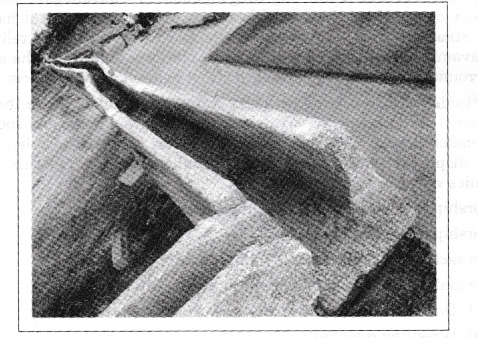
So the rulers of the Vijayanagara got built large embankments to store water. They also constructed reservoirs of varying sizes. They also make arrangements to store the rainwater as this was the most arid zone of the peninsula. A very large tank was found built in the fifteenth century to store water. The water tank presently known as Kamalapuram tank. The water of this tank was used for several Royal centre purposes.
(i)The water from the tank was used to irrigate the nearby fields.
(ii)The water of tank fulfilled the needs of the Royal centre.
(iii)The Hiriya canal drew water from a dam across the Tungabhadra river which was used for irrigation.
3. What do you think were the advantages and disadvantages of enclosing agricultural land within the fortified area of the city?
Ans: The advantages and disadvantages of enclosing agricultural land within the fortified areas of the city were as follows :
(а) Advantages :
- During the medieval period, the objective of seiges was to starve the defenders into submission. These seiges could last for a long period. Normally, rulers tried to be prepared for such situations by building large granaries with the fortified areas. The rulers of Vijayanagara adopted a more elaborate strategy of protecting the agricultural belt itself.
- As the agricultural tract was within fortified area, the peasants did not face any problems in cultivating the land due to war or any other reason. The peasants, therefore, did not face any financial difficulty.
- Land revenue was one of the main source of income of the state. Thus, with the protection of agricultural tract, there was regular income from this source.
- There was an agricultural tract between the sacred centre and the urban core. This tract had an elaborate canal system drawing water from the Tungabhadra. So, there was no problem of irrigation too.
(b) Disadvantages :
- Such an elaborate system of fortification was very expensive.
- The state has to maintain a large army for the protection of a bigger fortified area.
- Sometimes it could have been difficult to decide how much land be included within the fortified area.
4. What do you think was the significance of the rituals associated with the mahanavami dibba?
Ans: The mahanavami Dibba was the King’s palace in Vijayanagara though there is no definite evidence. From the available source we can guess that it had very beautiful wooden structure with base of the platform was covered with relief carvings. The Mahanavami Dibba had a very impressive platform known as “the audience hall”. It was surrounded by high double walls a street running between them.
Many rituals were associated with the Mahanavami dibba. Here the Hindu Festival Mahanavami or Navaratri were celebrated with a great pomp and show in the months of September-October. This festival continued for 9 days. The rulers of Vijayanagara Empire displayed their power, prestige and suzerainty. On this occasion several ceremonies were performed this included:
(i) Worship of the different gods and goddesses
(ii) Worship of the state horse.
(iii) The sacrifice of buffaloes and other animals.
(iv) The main attraction of this occasion were:
(a) Dances
(b) Wrestling matches
(c) Processions of horses, elephants, chariots and soldiers.
All these ceremonies presented before the king and his guests. On the last day of the festival, the king inspected his army as well as the nayakas of the army. He also accepted gift from the nayakas.
5. Fig. 7.33 is an illustration of another pillar from the Virupaksha temple. Do you notice any floral motifs? What are the animals shown? Why do you think they are depicted? Describe the human figures shown.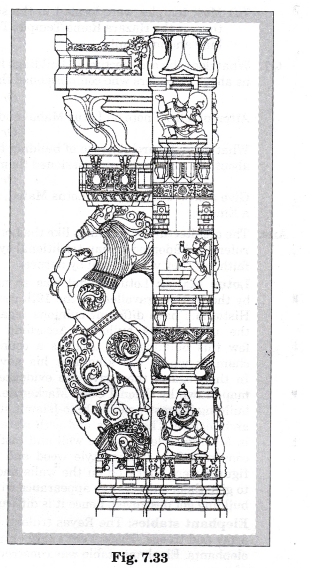
Ans: Given illustration of the pillar from the Virupaksha temple has pictures of plants bearing flowers and different animals-birds. Animals, birds include peacock, horse, duck, etc. These pictures were probably carved out on gateways to attract people. These pictures also express devotion, religiousness and-love for art of patronage ruler. Except this various kinds of animals and birds were associated with different gods and goddesses.
That was why they were also worshipped. Human pictures include both deities and their worshippers respectively. A god is shown wearing malas and crown. He also has gadda in his hands. Probably he was the destroyer of Rakshashas. In another picture devotee is shown near the ‘Shivlinga’ His method of worship is also strange which is not applicable in any form.
6. Discuss whether the term “royal centre” is an appropriate description for the part of the city for which it is used.
Ans: The term “royal centre” is not an appropriate description for the part of the city for which it is used due to following reasons :
- It included over 60 temples. On the other hand, there were only thirty building complexes that have been identified as palaces. These structures were made of perishable materials.
- The “king’s palace” is the largest enclosures but it has not yet yielded definitive evidence of being a royal residence. It has two impressive platforms – “audience hall” and the mahanavami dibba. It is not clear what “audience hall” was used for. Similarly space surrounding the structure of mahanavami dibba does not seem to have been adequate elaborate functions.
- Another beautiful building is Lotus Mahal. But again the historians are not clear for what this building was used. It may be a council chamber.
Thus, the terms “royal centre” is not proper to be used for this part of the city.
7. What does the architecture of buildings like the Lotus Mahal and elephant stables tell us about the rulers who commissioned them? (or)
Attempt a brief note on Lotus Mahal and elephant stables. (or)
What does the architecture of building like Lotus Mahal and elephant stables tell us about the rulers who commissioned them? (or)
Give a brief description of Lotus Mahal, situated in Royal centres of the Vijayanagara a Empire.
Ans: The architecture of buildings like the Lotus Mahal and elephant stables tell us that the rulers had adopted Indian traditional symbol, signs, and totems. They were Hindu by faith but they were liberal by nature.
Lotus Mahal: Lotus Mahal was so named by the British travellers in the 19th century.
Historians have different opinions regarding the use of this building. According to a few this building was used as a council of chamber where the king met his advisers.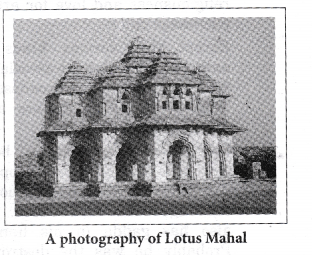
In this regard, they gave the evidence of a map drawn by Colonel Colin Mackenzie. This building is constructed in Indo-Islamic style of architecture. The pillars and arch were built in Muslim style while the wall and roof were constructed in Indian style wood and stone figures were engraved on the walls and roof to give them a decorative appearance with the passage of time to the most part of this building got destroyed, hence it is difficult to guess its grandeur.
Elephant stables: The Rayas (rulers) of the Vijayanagara maintained a very large army and troops. There were a large number of elephants in the army. To keep these elephants, Elephant stable was constructed near the Lotus Mahal in which a number of rooms were lined.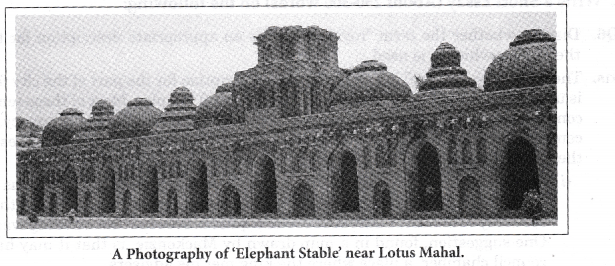
8. What are the architectural traditions that inspired the architects of Vijayanagara? How did they transform these traditions?
Ans: The rulers of Vijayanagara were known for their many innovations in the sphere of architectural traditions. They built many new temples which presented their architectural skills. They also added many new features in the temple architecture. For example, they built gopurams and royal gateways. The towers of the central shrines signalled the presence of the temple from a great distance. But the royal gateways surpassed the kings. They showed that the kings had full command over the resources, techniques and skills.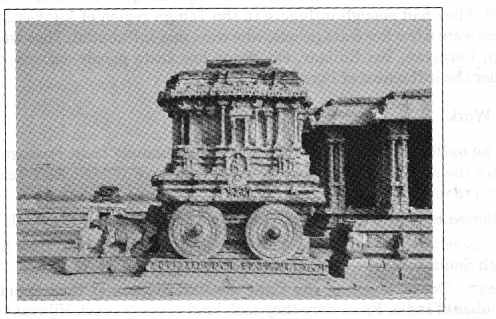
Other distinctive features of architectural style includes the constructions of mandapas or pavilions and pillared corridors that ran around the shrines. There were two main temples. The Virupaksha temple and the Vitthala Temple.
The Virupaksha temple was constructed in the 9th-10th centuries. But after the establishment of Vijayanagara Empire, it was substantially enlarged. Krishnadeva Raya built one of the most powerful ruler of the empire, built a hall in front of the main shrine to mark his accession to the throne. It was decorated with delicately carved pillars. Many temple complexes had chariot streets. These streets extended from the temple gopuram in a straight line. They were paved with slabs of stone and lied with pillared pavilions. In which merchants have set up their shops. In other words, the rulars of Vijayanagara built impressive buildings.
9. What impression of the lives of the ordinary people of Vijayanagara can you cull from the various descriptions in the chapter?
Ans: Ordinary people were those people who did not take part in power structure. They spoke different languages and follow different religious traditions. They consisted of small traders and local merchants. They use to live in cities, trade centres, port, towns, and villages. Local communities of merchants known as kudirai chettis or horse merchants participated in exchanges.
People such as peasants, workers, slaves, etc. were also included in ordinary people.
The workers were known as “Vipra viodin”. This group of ironsmiths, goldsmiths, carpenters, sculpture-makers, etc. Who often quarrelled mutually for their right. It seems that during that period, need was felt to frame laws for the society to execute social justice.
Kaikkol known as the weavers were in large numbers. They lived near temples. They played significant role in running the administration of the temple. In Vijayanagara state there were Gadarias known as Kambalattar. They followed the customs of polyandry. The special characteristic was that the wife was elder to the husband. Their women had physical relations with the husband’s kinsmen like father, brothers were prevalent.
There was an orthodox bigot section in Vijayanagara called as reddis who owned the land. They had enough influence in the Telugu region of Vijayanagara. In the society there were a few low class people, who were non-influential. They were Domber, Marva,Jogi, Paraiyan, Boi Kallaar, etc. Some low caste people converted into Christianity under the influences of Portuguese.
10. On an outline map of the world, mark approximately Italy, Portugal, Iran and Russia.
Ans: Followed by routes to reach Vijayanagara from Italy and Portugal:
The travellers crossed the Red Sea, Arabian Sea and then, they taken land route to reach South India.
Atlantic Ocean touching the Cape of Good Hope and then Indian Ocean to reach Malabar of India. From here they took land route to reach Vijayanagara.
The Italian travellers crossed the Arabian Sea and then Indian Ocean and through Malabar coast they reached Vijayanagara. From Iran via Afghanistan and modern Pakistan they would have taken land route upto Karnataka, India.
Russian came to India via Afghanistan. They crossed modern Punjab in Pakistan, central India crossing Vindhyachal, Satpura to Karnataka.
.png)
.jpeg)
.jpeg)
.png)
0 comments:
Post a Comment